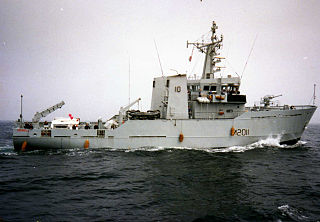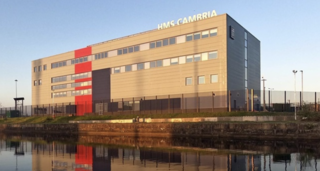
The River class was a class of minesweeper built for the British Royal Navy in the 1980s, designated Fleet Minesweepers (MSF).

The British Royal Navy operated large numbers of small Motor Minesweepers (MMS) during the Second World War, in two major classes: the first with 105 ft (32 m) hulls and the second with 126 ft (38 m) hulls. Intended to counter magnetic influence mines in coastal waters, they had wooden hulls.
Seven ships of the Royal Navy have been named HMS Venturer, with an eighth announced:

The Venturer-class minesweepers were naval trawlers converted from fishing trawlers to minesweeper service for the Royal Navy in 1978.
USS Limpkin (AMc-48) was an Accentor-class coastal minesweeper acquired by the United States Navy for clearing coastal minefields. The vessel was launched on 5 April 1941 and entered service on 8 August. Limpkin operated off New York City and the mouth of Chesapeake Bay during World War II. Following the war, the minesweeper was taken out of service on 15 April 1946 and sold to private interests and converted to a commercial trawler. The ship was renamed Hiawatha and then Blue Waters.

The Fundy-class minesweepers were a class of four minesweepers operated by the Royal Canadian Navy during the Second World War. All four ships entered service in 1938 and the class were discarded in 1945, sold for mercantile service. Three ended up sold to Chinese interests, while one remained active in Canada until 1987.

The Royal Naval Patrol Service (RNPS) was a branch of the Royal Navy active during both the First and Second World Wars. The RNPS operated many small auxiliary vessels such as naval trawlers for anti-submarine and minesweeping operations to protect coastal Britain and convoys.
Three ships of the Royal Navy have borne the name HMS St David, after Saint David, patron saint of Wales:

The Port of Lowestoft is a harbour and commercial port in Lowestoft in the English county of Suffolk owned by Associated British Ports. It is the most easterly harbour in the United Kingdom and has direct sea access to the North Sea. The harbour is made up of two sections divided by a bascule bridge. The inner harbour is formed by Lake Lothing whilst the outer harbour is constructed from breakwaters. Lowestoft handles around 30,000 tonnes of cargo per year.

Mincarlo is the last surviving sidewinder fishing trawler of the Lowestoft fishing fleet. She is also the last surviving fishing vessel built in Lowestoft, with an engine made in the town.
HMS Hodgeston was a Ton-class minesweeper which saw service with the Royal Navy during the Cold War. Built by Fleetlands Shipyard, she was launched on 6 April 1954 and broken up in 1988.

HMS Cambria is the lead Royal Naval Reserve unit in Wales. It is based at Sully near the Welsh capital, Cardiff.

RV George Bligh (LO309) was a fisheries research vessel that was operated by the Directorate of Fisheries, now known as the Centre for Environment, Fisheries and Aquaculture Science (Cefas).
The SY Hildegarde and the SY Hiawatha were steam yachts chartered by the Ministry of Agriculture, Fisheries and Food - Directorate of Fisheries, now known as the Centre for Environment, Fisheries and Aquaculture Science (Cefas) between 1912 and 1914 to carry out fishery investigations.
Richards (Shipbuilders) Ltd was a shipyard in Lowestoft, Suffolk.
Type 792 naval trawler is a Chinese auxiliary ship of the People's Liberation Army Navy (PLAN), deployed as intelligence gathering spy ship. Type 792 and its predecessor Type 8154, along with Type 8105 naval trawlers have all received NATO reporting name FT-14 AIT class, meaning Fishing Trawler - 14 Auxiliary Intelligence-gathering Trawler.

HMSAS Protea was the first hydrographic survey ship used by the South African Naval Service. The ship was laid down as a minesweeper to be named HMS Ventnor in 1917 but was renamed HMS Verwood in 1918 before she was launched. She was again re-named and launched as HMS Crozier on 1 July 1919. The vessel was converted from a minesweeper to a hydropraphic survey vessel in 1921 and transferred to the South African forces in 1922, where she was commissioned as HMSAS Protea. She served as a survey vessel until 1933 when she was returned to the Royal Navy. Protea was eventually sold by the Royal Navy and renamed MV Queen of the Bay where she went on to operate as a pleasure craft out of Blackpool. She was subsequently sold to the Spanish Navy and renamed Lieutenant Captain Remigio Verdia, and used as supply vessel to run blockades, smuggling supplies to the anti-fascists in Spain during the civil war. She ran aground and sunk off Cartagena in Spain in 1939.
HMS St David was a Venturer-class minesweeper converted from the fishing trawler Suffolk Monarch for the Royal Navy in 1978.










